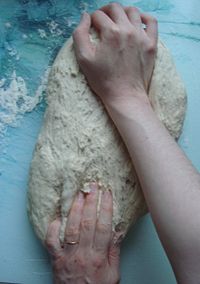
Kneading
Encyclopedia

- For kneading of clay, see wedging
Kneading is a process in the making of bread
Bread
Bread is a staple food prepared by cooking a dough of flour and water and often additional ingredients. Doughs are usually baked, but in some cuisines breads are steamed , fried , or baked on an unoiled frying pan . It may be leavened or unleavened...
or pasta
Pasta
Pasta is a staple food of traditional Italian cuisine, now of worldwide renown. It takes the form of unleavened dough, made in Italy, mostly of durum wheat , water and sometimes eggs. Pasta comes in a variety of different shapes that serve for both decoration and to act as a carrier for the...
dough, used to mix together the ingredients and add strength to the final product. Its importance lies in the mixing of flour
Flour
Flour is a powder which is made by grinding cereal grains, other seeds or roots . It is the main ingredient of bread, which is a staple food for many cultures, making the availability of adequate supplies of flour a major economic and political issue at various times throughout history...
with water
Water
Water is a chemical substance with the chemical formula H2O. A water molecule contains one oxygen and two hydrogen atoms connected by covalent bonds. Water is a liquid at ambient conditions, but it often co-exists on Earth with its solid state, ice, and gaseous state . Water also exists in a...
. When these two ingredients are combined and kneaded, the gliadin
Gliadin
Gliadin is a glycoprotein present in wheat and several other cereals within the grass genus Triticum. Gliadins are prolamins and are separated on the basis of electrophoretic mobility and isoelectric focusing.- Types :...
and glutenin
Glutenin
Glutenin is the glutelin derived from wheat. Gluteninis a protein best known for its role, along with gliadin, in the creation of gluten with its disulfide inter- and intra-molecule links. Glutenin consists of 20% HMW subunits, which are relatively low in sulfur...
proteins in the flour expand and form strands of gluten
Gluten
Gluten is a protein composite found in foods processed from wheat and related grain species, including barley and rye...
, which gives bread its texture. (To aid gluten production, many recipes use bread flour
Flour
Flour is a powder which is made by grinding cereal grains, other seeds or roots . It is the main ingredient of bread, which is a staple food for many cultures, making the availability of adequate supplies of flour a major economic and political issue at various times throughout history...
, which is higher in protein than all-purpose flour.) The kneading process warms and stretches these gluten strands, eventually creating a springy and elastic dough. If bread dough is not kneaded enough, it will not be able to hold the tiny pockets of gas (CO2) created by the leavening agent
Leavening agent
A leavening agent is any one of a number of substances used in doughs and batters that cause a foaming action which lightens and softens the finished product...
(such as yeast
Yeast
Yeasts are eukaryotic micro-organisms classified in the kingdom Fungi, with 1,500 species currently described estimated to be only 1% of all fungal species. Most reproduce asexually by mitosis, and many do so by an asymmetric division process called budding...
or baking powder
Baking powder
Baking powder is a dry chemical leavening agent used to increase the volume and lighten the texture of baked goods such as muffins, cakes, scones and American-style biscuits. Baking powder works by releasing carbon dioxide gas into a batter or dough through an acid-base reaction, causing bubbles in...
), and will collapse, leaving a heavy and dense loaf.
Kneading can be performed with a breadmaker, a mixer
Mixer (cooking)
A mixer is a kitchen appliance intended for mixing, folding, beating, and whipping food ingredients. Mixers come in two major variations, hand mixers and stand mixers....
equipped with a dough hook, or by hand. The dough is put on a floured surface, pressed and stretched with the heel of the hand, folded over, and rotated through 90º repeatedly. This process continues until the dough is elastic and smooth. The dough can then be allowed to rise or "prove
Proofing (baking technique)
Proofing , as the term is used by professional bakers, is the final dough-rise step before baking, and refers to a specific rest period within the more generalized process known as fermentation...
".
Similar to kneading is knocking back or punching down, which is done to the dough after proving. The dough is punched once or twice, after which it is kneaded gently for a short time. The aim of this is to remove any large air pockets which have formed in the dough, create an even texture in the bread and redistribute the nutrients for the yeast, thus allowing fermentation to continue. The dough can then be proved a second time. Another method of knocking back (also known as "folding") is to gently stretch and pat out the proved dough before folding the sides in towards the centre.
In bread baking, kneading can be substituted by allowing a relatively wet, low-yeast dough to rise for more than twelve hours; this method is referred to as no-knead bread
No-knead bread
No-knead bread is a method of bread baking that uses a very long rising time instead of kneading to form the gluten strands that give the bread its texture. It is characterized by a low yeast content and a very wet dough...
.

